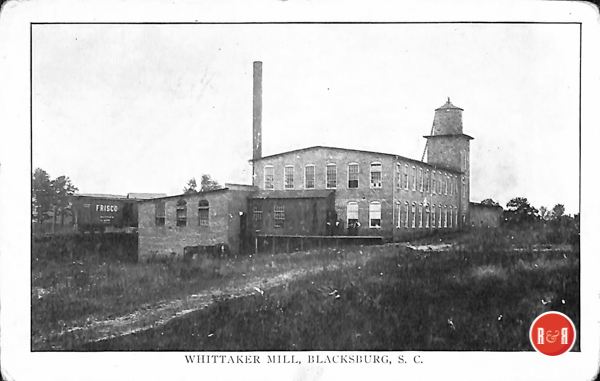City Directories and History: The Yorkville Enquirer reported on Oct. 17, 1888 – “A commission has been issued by the Sec. of State to the Broad River Cotton Mills, to be located at Blacks. The capital stock is $50,000. The incorporators are: D.D. Gaston, J.G. Black, F.M. Hardin, A.B. Crosby, Wm. Anderson, W.R. Reese, J.F. Jones, and N.W. Hardin.”
The Rock Hill Herald reported on May 30, 1896 – “That the Manufacturers Record, reported an investment of $50,000. for a new textile mill in Blacksburg.”

Also known as the Whitaker Mill. Image courtesy of the AFLLC Collection – 2017
The Rock Hill Record reported on Oct. 31, 1907 – “That a new mill will be organized in Blacksburg. Mr. G. Lang Anderson is proposing a company which will erect a $250,000. mill at the junction of the Southern RR main line and the Kingsville-Marion Line, once known as the 3C’s railroad.” (R&R is not certain this is the same mill as above or that it was ever completed.)
The Rock Hill Record reported on Jan 23, 1908 – “Mr. J. E. Sirrine, the well known architect and engineer, is drawing plans for a $300,000., cotton mill to be erected at Blacksburg by a new company organized by Mr. G. Lang Anderson, who is Sec. of the Williamston Mills. This mill will manufacture fine sheeting.”
The Rock Hill Record reported on April 13, 1908 – “The Blacksburg Mills is beginning construction of the plant. It will have 5,000 spindles and 128 looms for the production of cotton cloth. J.E. Sirrine of Greenville is architect and engineer. The building will be 150-200 ft., Mr. G. Lang Anderson of Williamston is the Co., President.”
The RH Record of Oct. 12, 1908 reported, “The Whitaker Cotton Mill at Blacksburg will resume operations after new machinery has been added in every department. It has been closed for several months.”
Early in his career, Sirrine was employed by the nationally renowned industrial architecture and engineering firm of Lockwood, Greene, and Company, in their newly established southern office in Greenville in the heart of the Carolinas textile belt. One of the most important firms of its type in the nation, the New England based Lockwood, Greene, and Company was formed in 1882 in Providence, Rhode Island, by Amos Lockwood and Stephen Greene. After Lockwood’s death in 1884, the business continued under the same name under the leadership of Stephen Greene (who died in 1901) and his son, Edwin, and beyond. Between 1884 and 1901, the company expanded dramatically, including establishment of a Boston office, pioneering work in electric power for textile mills, and development of southern markets.
When Lockwood, Greene was planning its first mill in Greenville in 1894, the firm employed the young civil engineer Joseph E. Sirrine to do some of the local work, and subsequently hired him for additional jobs. In 1898 Sirrine became a full-time employee, and when the company established its first regional branch office, the southern office in Greenville, Sirrine became head of the office and southern manager for the firm. According to a history of the company, Sirrine “represented Greene on all work in this territory until the latter’s death in 1901.” Sirrine is said to have supervised from six to eight mill jobs at the same time, a total of about twenty mills in the three-year period. His role appears to have been primarily supervisory, with much of the actual engineering and architectural work coming from the firm’s office in Boston. During his tenure, the Lockwood, Greene Company planned many factories—most of them in South Carolina—among which the immense Loray Mill (1900-1902) in Gastonia, North Carolina, was especially important as one of the largest and most technologically advanced mills in the nation. Sirrine’s initials, J. E. S., appear on a plan of the Loray village, showing the layout of streets and buildings. Frank W. Reynolds, another Lockwood, Greene employee, initialed the drawings for the mill itself. Sirrine’s involvement in these and other Lockwood, Greene projects requires further research…… (Click on the Thread link to read more….) Courtesy of Architects and Builders of NC
Stay Connected
Explore history, houses, and stories across S.C. Your membership provides you with updates on regional topics, information on historic research, preservation, and monthly feature articles. But remember R&R wants to hear from you and assist in preserving your own family genealogy and memorabilia.
Visit the Southern Queries – Forum to receive assistance in answering questions, discuss genealogy, and enjoy exploring preservation topics with other members. Also listed are several history and genealogical researchers for hire.
User comments welcome — post at the bottom of this page.
Please enjoy this structure and all those listed in Roots and Recall. But remember each is private property. So view them from a distance or from a public area such as the sidewalk or public road.
Do you have information to share and preserve? Family, school, church, or other older photos and stories are welcome. Send them digitally through the “Share Your Story” link, so they too might be posted on Roots and Recall.
Thanks!
User comments always welcome - please post at the bottom of this page.





Share Your Comments & Feedback: